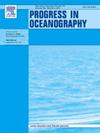Seasonal variability in surface water pCO2 and air-sea CO2 fluxes in the Northwestern Pacific Ocean
IF 3.6
3区 地球科学
Q1 OCEANOGRAPHY
引用次数: 0
Abstract
The Northwestern Pacific Ocean is one of the most important carbon sink regions globally. However, spatial variability and seasonal amplitude of surface water CO2 partial pressure (pCO2) and air-sea CO2 fluxes remain unresolved. Surface seawater pCO2 and auxiliary parameters were investigated in the Northwestern Pacific (10–33°N, 120–158°E) during spring, summer and winter in 2019 and 2020. The air-sea CO2 fluxes exhibited pronounced seasonal variability, acting as a CO2 sink of 5.0 ± 4.1 mmol m−2 d−1 in winter and a CO2 source of 1.7 ± 1.6 mmol m−2 d−1 in summer. In summer, the CO2 source increased with latitude, with the 10–14°N sub-region near equilibrium with the atmosphere (0.6 ± 0.6 mmol m−2 d−1) and the 27–33°N sub-region displaying the strongest source (3.6 ± 2.1 mmol m−2 d−1). The air-sea CO2 flux is primarily driven by variability in surface water pCO2. During summer, surface water pCO2 increases with latitude (408.4 ± 5.1, 418.2 ± 9.0 and 455.5 ± 12.4 μatm in 10–14°N, 14–27°N and 27–33°N, respectively), showing a “strange” pattern inverse with sea surface temperature. Temperature normalized pCO2 (NpCO2) also increases with latitude. In winter, surface water pCO2 generally decreases with latitude (379.4 ± 3.8, 372.9 ± 9.1 and 354.5 ± 3.6 μatm in 10–14°N, 14–27°N and 27–33°N, respectively), but NpCO2 increased with latitude (356.7 ± 7.7, 387.2 ± 13.1 and 434.4 ± 4.4 μatm in 10–14°N, 14–27°N and 27–33°N, respectively). In addition to the dominating temperature effect, different sub-regions have their own unique processes that affect the pCO2 behavior which in turn influences the air-sea CO2 fluxes. In the western zone (west of 130°E) of the 10-14°N sub-region, precipitation reduces pCO2 by 12.4 ± 5.2 μatm in summer and 14.8 ± 4.4 μatm in winter. In the 14-27°N sub-region, the relatively high NpCO2 is primarily driven by evaporation, with elevated salinity increasing surface water NpCO2 by 11.1 ± 12.7 μatm in summer and 7.7 ± 15.3 μatm in winter. The 27–33°N sub-region is located in the Subtropical Mode Water and atmospheric CO2 intrusion (increasing pCO2 by 44.2 μatm) also have important contributions to the high NpCO2. Under the context of global warming, the regional changes, such as variations in evaporation and precipitation, have the potential to significantly alter global ocean CO2 sink/source patterns and weaken the surface ocean’s CO2 sequestration ability.
西北太平洋地表水二氧化碳分压和海气二氧化碳通量的季节变化
西北太平洋是全球最重要的碳汇区之一。然而,地表水CO2分压(pCO2)和海气CO2通量的空间变异性和季节振幅仍未得到解决。对2019年和2020年春夏冬季西北太平洋(10-33°N, 120-158°E)表层海水pCO2及其辅助参数进行了研究。海气CO2通量表现出明显的季节变化,冬季为5.0±4.1 mmol m−2 d−1的CO2汇,夏季为1.7±1.6 mmol m−2 d−1的CO2源。夏季CO2源随纬度增加,其中10-14°N区域与大气接近平衡(0.6±0.6 mmol m−2 d−1),27-33°N区域CO2源最强(3.6±2.1 mmol m−2 d−1)。海气CO2通量主要由地表水二氧化碳分压的变率驱动。夏季,表层水体pCO2随纬度增加(10-14°N、14-27°N和27-33°N分别为408.4±5.1、418.2±9.0和455.5±12.4 μatm),与海面温度呈“奇异”逆变化。温度归一化pCO2 (NpCO2)也随纬度增加而增加。冬季地表水pCO2总体上随纬度降低(10-14°N、14-27°N和27-33°N分别为379.4±3.8、372.9±9.1和354.5±3.6 μatm),而NpCO2随纬度升高(10-14°N、14-27°N和27-33°N分别为356.7±7.7、387.2±13.1和434.4±4.4 μatm)。除了占主导地位的温度效应外,不同子区域有其独特的过程影响pCO2行为,进而影响海气CO2通量。在10-14°N亚区西部(130°E以西),降水使pCO2夏季减少12.4±5.2 μatm,冬季减少14.8±4.4 μatm。在14-27°N区域,相对较高的NpCO2主要由蒸发驱动,盐度升高使夏季地表水NpCO2增加11.1±12.7 μatm,冬季增加7.7±15.3 μatm。27-33°N亚区处于副热带模态,水汽和大气CO2入侵(增加了44.2 μatm)对NpCO2高值也有重要贡献。在全球变暖背景下,蒸发和降水等区域变化有可能显著改变全球海洋CO2汇源格局,削弱表层海洋的CO2固存能力。
本文章由计算机程序翻译,如有差异,请以英文原文为准。
求助全文
约1分钟内获得全文
求助全文
来源期刊

Progress in Oceanography
地学-海洋学
CiteScore
7.20
自引率
4.90%
发文量
138
审稿时长
3 months
期刊介绍:
Progress in Oceanography publishes the longer, more comprehensive papers that most oceanographers feel are necessary, on occasion, to do justice to their work. Contributions are generally either a review of an aspect of oceanography or a treatise on an expanding oceanographic subject. The articles cover the entire spectrum of disciplines within the science of oceanography. Occasionally volumes are devoted to collections of papers and conference proceedings of exceptional interest. Essential reading for all oceanographers.
 求助内容:
求助内容: 应助结果提醒方式:
应助结果提醒方式:


